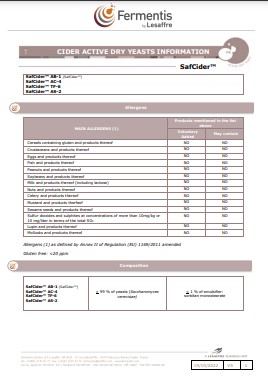Ваш кошик
Ваш кошик порожній
Новини компанії
Наші спеції
Наш цукор
Наші кришки
-
 Кришки для кег 64мм, Червоні 102 Sankey S-тип (ЄС) (1000/Коробка)
Додати до кошика
Кришки для кег 64мм, Червоні 102 Sankey S-тип (ЄС) (1000/Коробка)
Додати до кошика
-
 Кришки для кег 69 мм, Чорний 91 Grundey G-тип (850/Коробка)
Додати до кошика
Кришки для кег 69 мм, Чорний 91 Grundey G-тип (850/Коробка)
Додати до кошика
-
 Кришки 26mm TFS-PVC Free, Green Transparent col. 2722 (10000/Коробка)
Додати до кошика
Кришки 26mm TFS-PVC Free, Green Transparent col. 2722 (10000/Коробка)
Додати до кошика
-

 Crown Caps 29mm TP-PVC Free, Gold NEU col. 4310 (6500/box)
Додати до кошика
Crown Caps 29mm TP-PVC Free, Gold NEU col. 4310 (6500/box)
Додати до кошика
-
 Кришки 26mm TFS-PVC Free, Blue Neu col. 2832 (10000/Коробка)
Додати до кошика
Кришки 26mm TFS-PVC Free, Blue Neu col. 2832 (10000/Коробка)
Додати до кошика
Рецепти пива
Словник
A tall glass (traditionally 3 feet) that was originally produced in England back in the days when travel by horse-drawn coach was common. When a coach would stop at an Inn to rest the horses and feed the passangers, the Coach driver would have to stay on the coach to handle the reigns. Since the coach driver wanted beer, but was way up there on the coach while the barmaids where way down there on the ground, the yard glass was developed to help the barmaids hand the beer up to the coach driver. A yard glass typically has a large mouth, a long skinny neck, and a large bulb at the bottom. It takes a bit of practice, but it certainly is an entertaining and traditional way to enjoy beer.
Yeast collected from fermentors during or after the fermentation.
A brewing additive which is typically produced by extracting the "guts" of yeast cells in a centrifuge. Provides essential nutrients to the yeast. Since barley malt already contains all of the nutrients that yeast need, yeast engergizer is generally unnecessary when brewing beer. It may be more helpful in wines, ciders and meads (fruit juices and honey do not contain the level of nutrients that barley does).
A brewing additive which adds free amino nitrogen (FAN), a substance which is essential for good yeast health. Think of it as fertilizer for your yeast. As with yeast engergizer, should not be necessary for beer wort, since malt already contains all of the essential nutrients for your yeast.
Essentially a small, mini-batch of beer, the sole purpose of which is to give your yeast culture a contaminant-free environment in which it can build up their strength and numbers. For detailed info on how I make yeast starters.
Number of pounds of extract, obtained from 100 pounds of brewing material, given in percent. Also kilos extract per kilo brewing material. Distinguish between laboratory yield of malt and adjunct which is determined by standard ASBC methods and brewhouse yield, which depends on equipment and operating conditions. Brewhouse yield ranges from 92 to 98% of laboratory yields.
English system of fermentation using shallow, square, traditionally slate vessels for fermentation. Still in use by the Samuel Smith Brewery in Tadcaster, Yorkshire.


















 Bio-Zertifikat DE - Juli 2025-März 2028
Bio-Zertifikat DE - Juli 2025-März 2028
 Fermentis - Cider Dry Yeast Information 2023
Fermentis - Cider Dry Yeast Information 2023
 Fagron Spices, IFSFood Certificate 16089, FR 2024
Fagron Spices, IFSFood Certificate 16089, FR 2024
 Hmezad Hops, Certificate ISO 9001:2015 (2025)
Hmezad Hops, Certificate ISO 9001:2015 (2025)
 Fagron Spices, GMO-free Certificate 2022
Fagron Spices, GMO-free Certificate 2022



